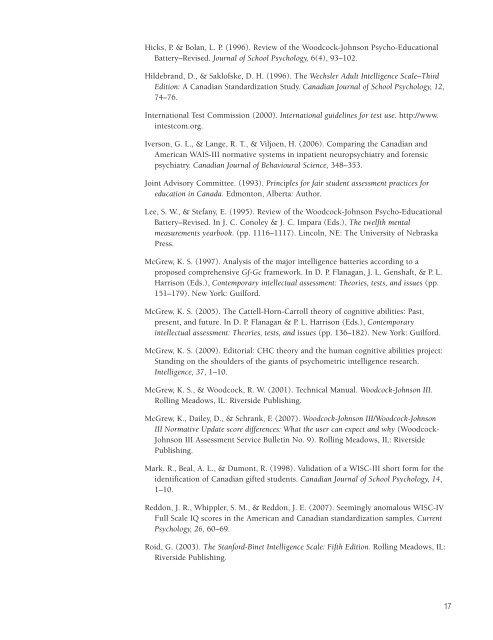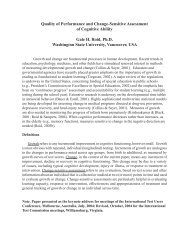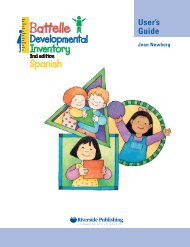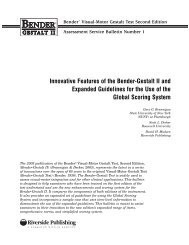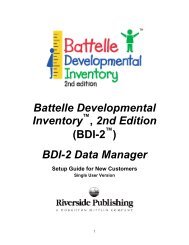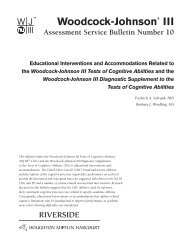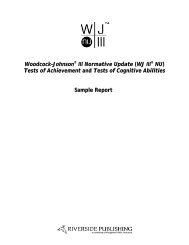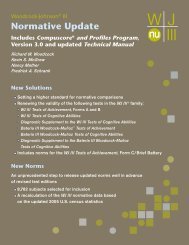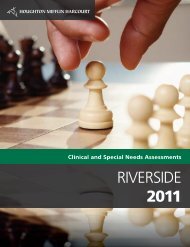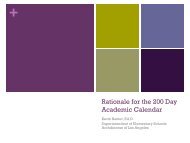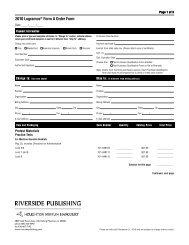Woodcock-Johnson® III - Riverside Publishing
Woodcock-Johnson® III - Riverside Publishing
Woodcock-Johnson® III - Riverside Publishing
- No tags were found...
You also want an ePaper? Increase the reach of your titles
YUMPU automatically turns print PDFs into web optimized ePapers that Google loves.
Hicks, P. & Bolan, L. P. (1996). Review of the <strong>Woodcock</strong>-Johnson Psycho-EducationalBattery–Revised. Journal of School Psychology, 6(4), 93–102.Hildebrand, D., & Saklofske, D. H. (1996). The Wechsler Adult Intelligence Scale–ThirdEdition: A Canadian Standardization Study. Canadian Journal of School Psychology, 12,74–76.International Test Commission (2000). International guidelines for test use. http://www.intestcom.org.Iverson, G. L., & Lange, R. T., & Viljoen, H. (2006). Comparing the Canadian andAmerican WAIS-<strong>III</strong> normative systems in inpatient neuropsychiatry and forensicpsychiatry. Canadian Journal of Behavioural Science, 348–353.Joint Advisory Committee. (1993). Principles for fair student assessment practices foreducation in Canada. Edmonton, Alberta: Author.Lee, S. W., & Stefany, E. (1995). Review of the <strong>Woodcock</strong>-Johnson Psycho-EducationalBattery–Revised. In J. C. Conoley & J. C. Impara (Eds.), The twelfth mentalmeasurements yearbook. (pp. 1116–1117). Lincoln, NE: The University of NebraskaPress.McGrew, K. S. (1997). Analysis of the major intelligence batteries according to aproposed comprehensive Gf-Gc framework. In D. P. Flanagan, J. L. Genshaft, & P. L.Harrison (Eds.), Contemporary intellectual assessment: Theories, tests, and issues (pp.151–179). New York: Guilford.McGrew, K. S. (2005). The Cattell-Horn-Carroll theory of cognitive abilities: Past,present, and future. In D. P. Flanagan & P. L. Harrison (Eds.), Contemporaryintellectual assessment: Theories, tests, and issues (pp. 136–182). New York: Guilford.McGrew, K. S. (2009). Editorial: CHC theory and the human cognitive abilities project:Standing on the shoulders of the giants of psychometric intelligence research.Intelligence, 37, 1–10.McGrew, K. S., & <strong>Woodcock</strong>, R. W. (2001). Technical Manual. <strong>Woodcock</strong>-Johnson <strong>III</strong>.Rolling Meadows, IL: <strong>Riverside</strong> <strong>Publishing</strong>.McGrew, K., Dailey, D., & Schrank, F. (2007). <strong>Woodcock</strong>-Johnson <strong>III</strong>/<strong>Woodcock</strong>-Johnson<strong>III</strong> Normative Update score differences: What the user can expect and why (<strong>Woodcock</strong>-Johnson <strong>III</strong> Assessment Service Bulletin No. 9). Rolling Meadows, IL: <strong>Riverside</strong><strong>Publishing</strong>.Mark. R., Beal, A. L., & Dumont, R. (1998). Validation of a WISC-<strong>III</strong> short form for theidentification of Canadian gifted students. Canadian Journal of School Psychology, 14,1–10.Reddon, J. R., Whippler, S. M., & Reddon, J. E. (2007). Seemingly anomalous WISC-IVFull Scale IQ scores in the American and Canadian standardization samples. CurrentPsychology, 26, 60–69.Roid, G. (2003). The Stanford-Binet Intelligence Scale: Fifth Edition. Rolling Meadows, IL:<strong>Riverside</strong> <strong>Publishing</strong>.17


